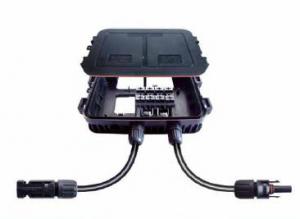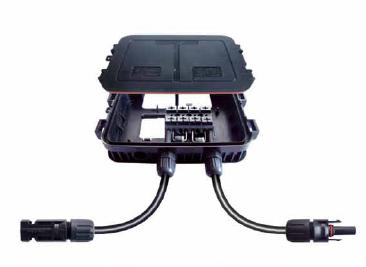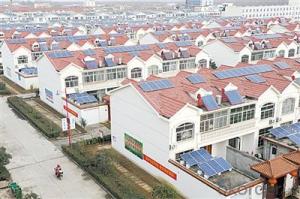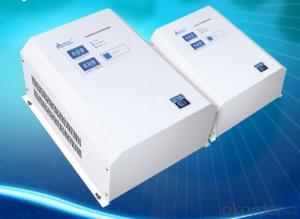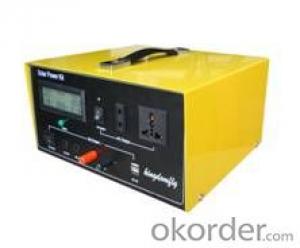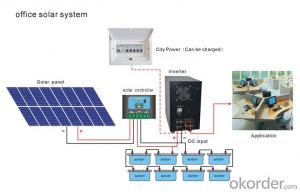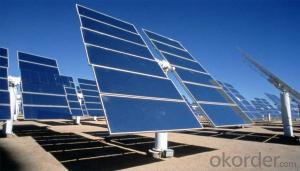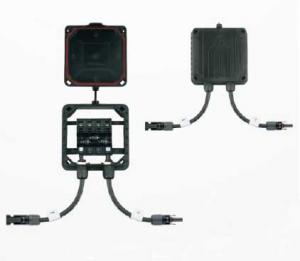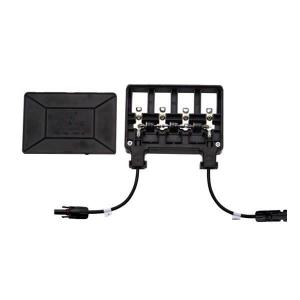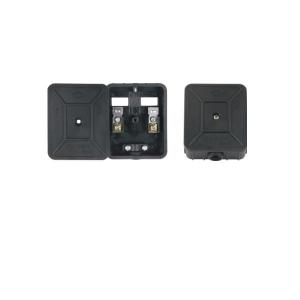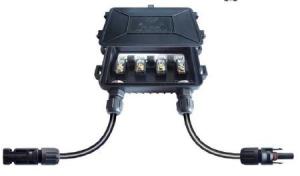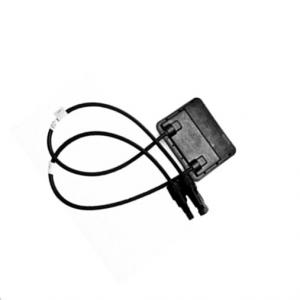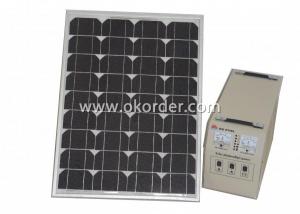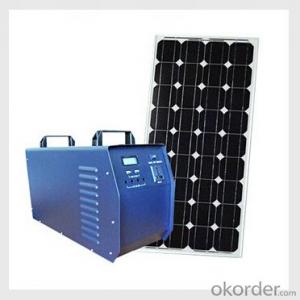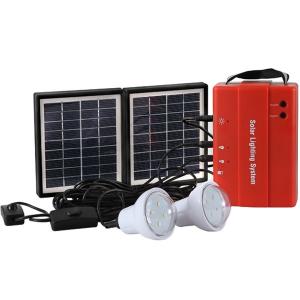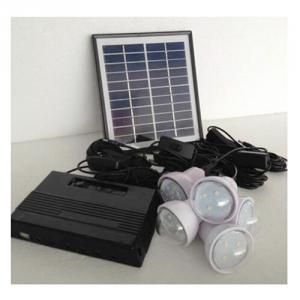Solar Junction box PV-JB003 ST01
- Loading Port:
- China Main Port
- Payment Terms:
- TT OR LC
- Min Order Qty:
- -
- Supply Capability:
- 10000 set/month
OKorder Service Pledge
OKorder Financial Service
You Might Also Like
PV-Junction box,Due to highly robustness,UV-resistance,the touch protection a high grade connection is guaranteed for many years
PV-Junction box
Rated voltage 1000 V
Rated current 30 A
Contact resistance ≤5mΩ
Dia of pin or socket 3mm /4mm
Protection degree(mated,junction box closed/unmated) IP65/IP2X
Operating temperature -40 C to +85C
Insulation material PPO
Contact material Copper,silver plated
Max.Heat dissipation Assessment should be make after final assembly of junction box
- Q: Can solar energy systems be used in powering hospitals or healthcare facilities?
- Yes, solar energy systems can certainly be used to power hospitals or healthcare facilities. In fact, many healthcare institutions around the world are already utilizing solar power as a sustainable and reliable source of electricity. Solar energy systems consist of photovoltaic (PV) panels that convert sunlight into electricity, which can be used to power various equipment and appliances within the facility. There are several advantages of using solar energy in healthcare facilities. Firstly, it helps reduce operational costs by providing a long-term and sustainable source of electricity. Hospitals and healthcare facilities require a significant amount of energy to operate medical equipment, lighting, heating, cooling, and other essential systems. By installing solar panels, these institutions can significantly lower their electricity bills and allocate their resources towards patient care. Secondly, solar energy systems contribute to environmental sustainability. Hospitals are known for their high energy consumption, and traditional energy sources often lead to increased carbon emissions and pollution. By switching to solar power, healthcare facilities can reduce their carbon footprint and promote a greener and healthier environment. This aligns with the healthcare industry's commitment to promoting public health and wellbeing. Moreover, solar energy systems can provide a reliable source of electricity, even during power outages or during emergencies. Hospitals and healthcare facilities require uninterrupted power supply to ensure the safety and wellbeing of patients. Solar energy systems can be integrated with battery storage solutions, allowing for the storage of excess electricity generated during the day for use during nighttime or when the sun is not shining. This ensures continuous power supply, even during periods of grid outages or natural disasters. It is worth noting that the installation of solar energy systems requires careful planning and design to meet the specific energy needs of hospitals and healthcare facilities. A thorough assessment of energy requirements, space availability, and system capacity is essential to ensure optimal performance and efficiency. Additionally, regular maintenance and monitoring are crucial to ensure the smooth operation of the solar energy system. Overall, solar energy systems offer numerous benefits for hospitals and healthcare facilities. They provide a cost-effective, sustainable, and reliable source of electricity, reduce carbon emissions, and contribute to the overall wellbeing of patients and the environment. As the healthcare industry continues to prioritize sustainability and environmental stewardship, the adoption of solar energy systems in powering hospitals is expected to increase.
- Q: Is solar energy reliable?
- Yes, solar energy is reliable. Solar panels can generate electricity as long as they are exposed to sunlight, which is abundant and available in most regions. Additionally, solar energy systems have a lifespan of 25-30 years, and with proper maintenance, they can consistently produce power during that period. The advancements in solar technology have also made it more efficient and cost-effective, making it a reliable source of renewable energy for both residential and commercial applications.
- Q: Can solar energy systems be installed on the ground?
- Indeed, ground-mounted solar energy systems are capable of being installed. In fact, they are a favored choice for both residential and commercial purposes. Typically, these systems consist of solar panels affixed to a structure or framework that is securely fastened to the ground. Compared to rooftop installations, ground-mounted systems offer several advantages, including greater flexibility in design, easier accessibility for maintenance and cleaning, and the ability to optimize panel orientation and tilt angle for maximum energy production. Furthermore, ground-mounted systems can be installed in areas with limited roof space or where the roof is unsuitable for solar panel placement. Overall, ground-mounted solar energy systems present a practical and efficient means of harnessing the sun's power for generating electricity.
- Q: How much sunlight is needed for a solar energy system to work effectively?
- The effectiveness of a solar energy system is influenced by several factors that cause the required amount of sunlight to vary. These factors include the efficiency of the solar panels, the location, the angle and orientation of the panels, and the time of year. To achieve maximum effectiveness, solar panels should ideally receive uninterrupted direct sunlight for a significant portion of the day. Direct sunlight refers to sunlight that reaches the panels without any obstacles like shadows from nearby buildings or trees. This unobstructed sunlight provides the highest energy level, thus optimizing the system's efficiency. Nevertheless, solar panels can still generate electricity even when direct sunlight is not available. They can produce energy in cloudy conditions or when sunlight is scattered. Although energy production may decrease in these situations, it is still possible to generate a substantial amount of electricity, especially due to advancements in solar panel technology. Geographical location is also critical in determining the amount of sunlight available. Areas closer to the equator generally receive more sunlight throughout the year, while regions farther from the equator may experience shorter days during certain seasons. Consequently, solar energy systems in equatorial regions may require less sunlight to operate effectively compared to those in areas with less sunlight. The angle and orientation of the solar panels also affect the system's effectiveness. Panels that are angled towards the sun and facing south in the northern hemisphere (or north in the southern hemisphere) maximize their exposure to sunlight. By optimizing the panel's position, the system can capture the highest possible amount of sunlight, thus enhancing its effectiveness. Lastly, the time of year impacts the sunlight received by a solar energy system. During summer months, when days are longer and the sun is higher in the sky, solar panels have greater access to sunlight, making them more effective. Conversely, during winter, when days are shorter and the sun is lower in the sky, the system may receive less sunlight, thus affecting its performance. In conclusion, the required amount of sunlight for a solar energy system to function effectively depends on various factors, including panel efficiency, location, orientation, and time of year. Although direct sunlight is preferable, solar panels can still generate electricity under cloudy or scattered sunlight conditions. Consulting with a solar energy professional is recommended to determine the specific sunlight requirements based on these factors for a particular system.
- Q: How do solar energy systems impact grid stability?
- Solar energy systems can have both positive and negative impacts on grid stability. On one hand, solar power can help enhance grid stability by reducing the strain on traditional power plants and diversifying the energy mix. Solar energy is typically generated during the day when demand is high, which can help meet peak demand and stabilize the grid. On the other hand, the intermittent nature of solar power can present challenges to grid stability, as it is dependent on weather conditions. This intermittency can lead to fluctuations in power generation, which may require additional grid management strategies and energy storage solutions to ensure stability.
- Q: Can solar energy systems be used in powering sports stadiums?
- Yes, solar energy systems can definitely be used to power sports stadiums. In fact, many stadiums around the world have already started implementing solar energy systems to meet their energy needs. Solar panels can be installed on the rooftops, parking lots, or open spaces surrounding the stadium to capture sunlight and convert it into electricity. The main advantage of using solar energy in powering sports stadiums is its sustainability and cost-effectiveness. Solar energy is a renewable source of energy that does not emit any greenhouse gases during its operation, making it environmentally friendly and helping to reduce carbon footprint. Moreover, once the initial investment is made in installing the solar panels, the ongoing operational costs are relatively low, which can result in significant savings on the stadium's energy bills. The size and structure of sports stadiums make them ideal candidates for solar energy systems. The large surface areas of stadiums provide ample space for installing a significant number of solar panels, which can generate a substantial amount of electricity. Additionally, the open spaces surrounding the stadium allow for optimal sunlight exposure, ensuring maximum energy generation. Furthermore, solar energy systems can be integrated with other technologies to enhance their efficiency and functionality. For instance, battery storage systems can be employed to store excess energy generated during the day and use it during night events or during periods of low sunlight. This ensures a continuous and reliable power supply to the stadium, regardless of the weather conditions or time of day. In conclusion, solar energy systems can definitely be used in powering sports stadiums. They offer a sustainable and cost-effective solution to meet the energy needs of these large facilities, while also reducing their environmental impact. With further advancements in solar technology and decreasing costs, it is expected that more sports stadiums worldwide will embrace solar energy as a primary source of power in the future.
- Q: Is it possible to sell excess electricity generated by a solar energy system?
- Yes, it is possible to sell excess electricity generated by a solar energy system. This can be done through net metering or feed-in tariff programs, where surplus electricity is fed back into the grid and credited or compensated by the utility company.
- Q: Can solar energy systems be used for powering streetlights or outdoor lighting?
- Yes, solar energy systems can be used for powering streetlights or outdoor lighting. Solar-powered streetlights and outdoor lighting systems are becoming increasingly popular due to their numerous benefits such as reduced electricity costs, lower environmental impact, and increased efficiency. These systems use photovoltaic panels to convert sunlight into electricity, which is then stored in batteries and used to power the lights during nighttime.
- Q: Can a solar energy system be installed on a metal roof?
- Yes, a solar energy system can be installed on a metal roof. In fact, metal roofs are often considered ideal for solar panel installation due to their durability and ease of installation. The metal roof provides a stable and secure surface for mounting the solar panels, and the sleek design of the panels can complement the aesthetics of the roof. Additionally, metal roofs are typically more resistant to weather elements such as hail, wind, and snow, which can further protect and prolong the lifespan of the solar energy system. With proper installation techniques and mounting hardware, a solar energy system can efficiently and effectively generate renewable energy on a metal roof.
- Q: Are solar energy systems suitable for all locations?
- No, solar energy systems are not suitable for all locations. The feasibility and efficiency of solar energy depend on various factors such as the amount of sunlight received, the availability of space for installing panels, and the local climate. Regions with low sunlight or frequent cloudy weather may not be ideal for solar energy systems. Additionally, areas with limited space or high levels of shading may also face challenges in harnessing solar power effectively.
Send your message to us
Solar Junction box PV-JB003 ST01
- Loading Port:
- China Main Port
- Payment Terms:
- TT OR LC
- Min Order Qty:
- -
- Supply Capability:
- 10000 set/month
OKorder Service Pledge
OKorder Financial Service
Similar products
Hot products
Hot Searches
Related keywords
